Some history notes:
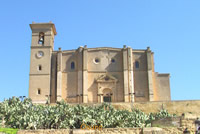 The origin of Osuna goes back three thousand years, when turdetanians inhabited the city that was named as Urso. In year 44-43 BC, it was re-established by roman Marco Antonio with veterans from the last civil wars, giving it the status of roman citizens and the official name of Genetiva Iulia Colonial, as it’s documented in some inscriptions.
The origin of Osuna goes back three thousand years, when turdetanians inhabited the city that was named as Urso. In year 44-43 BC, it was re-established by roman Marco Antonio with veterans from the last civil wars, giving it the status of roman citizens and the official name of Genetiva Iulia Colonial, as it’s documented in some inscriptions.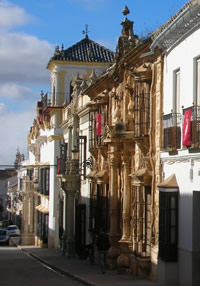 It still preserves its foundational colonial law, an important bronze inscription on some tablets, known as Lex Ursonensis (however the name Urso does not appeared once), displayed in Madrid´s Archaeological Museum. A century later, Pliny the Elder named the city as Generiva Urbanorum Uso Colonial (NH, III.12).
It still preserves its foundational colonial law, an important bronze inscription on some tablets, known as Lex Ursonensis (however the name Urso does not appeared once), displayed in Madrid´s Archaeological Museum. A century later, Pliny the Elder named the city as Generiva Urbanorum Uso Colonial (NH, III.12).
During the Islamic period it was called Oxona, being conquered in 1239 by Fernando III ‘The Saint’ castellan army. In 1264 it is given to Clatrava´s Orde, creating the entrustment of Osuna. Thanks to the strategic position, it becomes a crucial defending point for the frontier with Granada´s nazari kingdom .During 15th century, calatravos knights gave the city of Osuna to D. Pedro Téllez de Girón, whose decedents received the title of Duke of Osuna during the reign of Felipe II
What to visit?
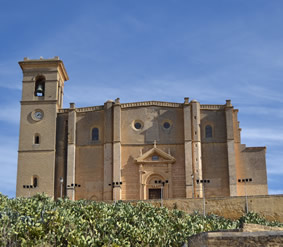 Osuna is an artistic, historical and monumental treasure trove. All around the locality we can find a great number of well-preserved ancestral houses, squares and palaces, with outstanding forged iron decoration and artistic patterns. In the entire village stone is the main building material, creating a well-kept heritage. Religious constructions are abundant and well located around the city. This is why it was declared a historical-artistic city in 1967.
Osuna is an artistic, historical and monumental treasure trove. All around the locality we can find a great number of well-preserved ancestral houses, squares and palaces, with outstanding forged iron decoration and artistic patterns. In the entire village stone is the main building material, creating a well-kept heritage. Religious constructions are abundant and well located around the city. This is why it was declared a historical-artistic city in 1967.
On the outskirts of the historic district there is wonderful scenery formed by gorges and crags called Las Canteras, where the Roman theatre and necropolis cave dwellings can be found, built between the 7th century BC and the Visigoths period.
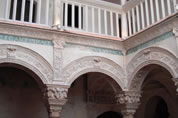
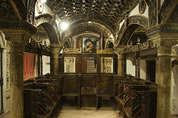
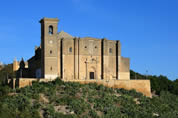
Osuna has some Islamic architectonic artefacts from the Almohad dynasty such as Torre Del Agua with several painting on its walls.
But it was during the 16th and 17th century when Osuna experienced it’s most opulent and magnificent period, when so many constructions were built during the Spanish Renaissance and Baroque period. Good examples are the University, the Ducal Pantheon and the “Colegiata” Church University, situated on a promontory in the Andalusian locality.
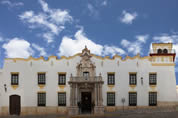
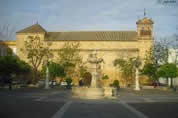
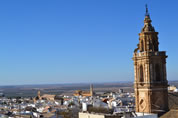
Another important baroque construction, and a tourist must see, is the Monasterio de la Encarnación, stopping to contemplate the 18th century ceramic that adorns it. At the Plaza Mayor, the historical important district’s monuments await us: the town hall, the Casino, the Convento de la Concepcion and the Torre del Agua.
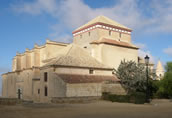 The most flamboyant architectonic public collection from the 16th and 17th century is located in Seville Street and San Pedro Street. We can point out The Marquis of la Gomera, the Cepeda or Govanes y Herdara palaces and the Antigua Audience building, that is now a residence for the elderly before being the hospital La Merced for some years, and before that was a municipal building where military recruitment took place.
The most flamboyant architectonic public collection from the 16th and 17th century is located in Seville Street and San Pedro Street. We can point out The Marquis of la Gomera, the Cepeda or Govanes y Herdara palaces and the Antigua Audience building, that is now a residence for the elderly before being the hospital La Merced for some years, and before that was a municipal building where military recruitment took place.
There are three museums to visit: Arte Sacro de la Colegiata, Convento de la Encarnación and Archaeological Museum in the Torre del Agua
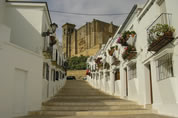 A large part of the territory is considered a protected natural space. The surrounding area has idyllic attributes so nature lovers can enjoy for example: trekking, horse riding or carp fishing in the lake and the River Corbones, one of few sailing lakes in the province of Seville. In the north part of Osuna there is a lagoon that receives the visit of different bird species such as flamingos, geese, herons or the nearly extinct malvasia duck. No doubt it is paradise for ornithology lovers.
A large part of the territory is considered a protected natural space. The surrounding area has idyllic attributes so nature lovers can enjoy for example: trekking, horse riding or carp fishing in the lake and the River Corbones, one of few sailing lakes in the province of Seville. In the north part of Osuna there is a lagoon that receives the visit of different bird species such as flamingos, geese, herons or the nearly extinct malvasia duck. No doubt it is paradise for ornithology lovers.
Festivities
Osuna is a fantastic place to enjoy the traditions of the area. Semana Santa (Holy Week) stands out from all celebration as it is declared Fiesta of National Tourist Interest in Andalusia, when centenarian wooden baroque sculptures (of religious images masters like Juan de Astorga, José Mora or Juan de Mesa) are taken around the decked out streets.
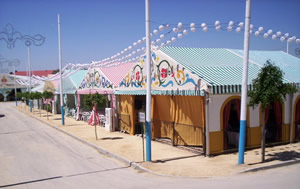 The other outstanding annual event is the fair of Osuna, established as a cattle trading fair by Charles IV (Carlos IV) Royal Resolution. As time has gone by it has change into a festive event, being one of the oldest in Spain (even older than the Seville Fair).
The other outstanding annual event is the fair of Osuna, established as a cattle trading fair by Charles IV (Carlos IV) Royal Resolution. As time has gone by it has change into a festive event, being one of the oldest in Spain (even older than the Seville Fair).
The Regional Council for the Tourism, Trade and Sport of the Junta of Andalusia has declared the May Fair of Osuna as a tourist interest in Andalusia, considering it a festival that contributes to the development of values and popular tradition of the municipality and of Andalusia, as for the promotion, development and diffusion of tourism.
Other traditional festivities are the Romería de Ntra. Sra. de Consolación and the celebrations of Ntra. Sra. De Consolación and San. Arcadio, patron saints of Osuna.
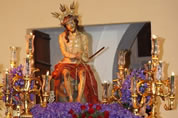
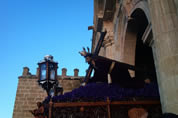
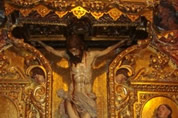
Gastronomy
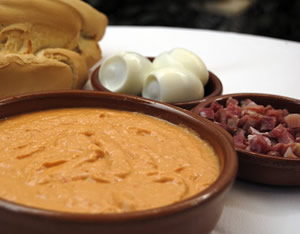 Seville’s culture is also transmitted by its gastronomy. Ardoria (salmorejo), made with garlic, tomatoes, bread, olive oil, ham and boiled eggs is one of the most typical starters in Osuna.
Seville’s culture is also transmitted by its gastronomy. Ardoria (salmorejo), made with garlic, tomatoes, bread, olive oil, ham and boiled eggs is one of the most typical starters in Osuna.
Diners should also try other dishes such as repapalillas, made with eggs, milk, flour, garlic, parsley, onion and codfish.
Pork and potato stew, migas, cocido ursanoés or bean and pea stew completes the most typical local dishes which are on offer.
In confectionery we can taste aldeanas of Santo Domingo´s patisserie, gachas from San Arcadio or sweets form Monasterio de la Encarnación.
Services
 There is an administrative area, with court of first instance, Guardia Civil, Patent Office that covers the entire region of Osuna, El Rubio, Lantejuela, El Saucejo and Martin de la Jara, Treasury Administration, National Social Security Institute delegation and General Treasury of the Social Security.
There is an administrative area, with court of first instance, Guardia Civil, Patent Office that covers the entire region of Osuna, El Rubio, Lantejuela, El Saucejo and Martin de la Jara, Treasury Administration, National Social Security Institute delegation and General Treasury of the Social Security.
Osuna also has a University with four bachelor degrees attached to the University of Seville (Social Work, Financial, Nursing, and Labour Relations) and recently extended University of Seville Language Institute and Regional Hospital.

Próximamente se podrá disfrutar de la nueva estación de trenes de alta velocidad (AVE) en el tramo Sevilla - Málaga, que forma parte del Eje Ferroviario Transversal de Andalucía, un proyecto que conectará las principales capitales andaluzas.
 The origin of Osuna goes back three thousand years, when turdetanians inhabited the city that was named as Urso. In year 44-43 BC, it was re-established by roman Marco Antonio with veterans from the last civil wars, giving it the status of roman citizens and the official name of Genetiva Iulia Colonial, as it’s documented in some inscriptions.
The origin of Osuna goes back three thousand years, when turdetanians inhabited the city that was named as Urso. In year 44-43 BC, it was re-established by roman Marco Antonio with veterans from the last civil wars, giving it the status of roman citizens and the official name of Genetiva Iulia Colonial, as it’s documented in some inscriptions. It still preserves its foundational colonial law, an important bronze inscription on some tablets, known as Lex Ursonensis (however the name Urso does not appeared once), displayed in Madrid´s Archaeological Museum. A century later, Pliny the Elder named the city as Generiva Urbanorum Uso Colonial (NH, III.12).
It still preserves its foundational colonial law, an important bronze inscription on some tablets, known as Lex Ursonensis (however the name Urso does not appeared once), displayed in Madrid´s Archaeological Museum. A century later, Pliny the Elder named the city as Generiva Urbanorum Uso Colonial (NH, III.12).
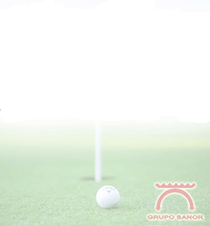
 Osuna, known as the Turdetanian Usro, extends along the slope of a small hill which served as a watchtower over the vast olive and cereal fields in the Sevillian countryside. Its long history has left interesting monuments and art pieces from the diverse cultures that were once established here.
Osuna, known as the Turdetanian Usro, extends along the slope of a small hill which served as a watchtower over the vast olive and cereal fields in the Sevillian countryside. Its long history has left interesting monuments and art pieces from the diverse cultures that were once established here.  Osuna is an artistic, historical and monumental treasure trove. All around the locality we can find a great number of well-preserved ancestral houses, squares and palaces, with outstanding forged iron decoration and artistic patterns. In the entire village stone is the main building material, creating a well-kept heritage. Religious constructions are abundant and well located around the city. This is why it was declared a historical-artistic city in 1967.
Osuna is an artistic, historical and monumental treasure trove. All around the locality we can find a great number of well-preserved ancestral houses, squares and palaces, with outstanding forged iron decoration and artistic patterns. In the entire village stone is the main building material, creating a well-kept heritage. Religious constructions are abundant and well located around the city. This is why it was declared a historical-artistic city in 1967. 







 The other outstanding annual event is the fair of Osuna, established as a cattle trading fair by Charles IV (Carlos IV) Royal Resolution. As time has gone by it has change into a festive event, being one of the oldest in Spain (even older than the Seville Fair).
The other outstanding annual event is the fair of Osuna, established as a cattle trading fair by Charles IV (Carlos IV) Royal Resolution. As time has gone by it has change into a festive event, being one of the oldest in Spain (even older than the Seville Fair).


 Seville’s culture is also transmitted by its gastronomy. Ardoria (salmorejo), made with garlic, tomatoes, bread, olive oil, ham and boiled eggs is one of the most typical starters in Osuna.
Seville’s culture is also transmitted by its gastronomy. Ardoria (salmorejo), made with garlic, tomatoes, bread, olive oil, ham and boiled eggs is one of the most typical starters in Osuna. There is an administrative area, with court of first instance, Guardia Civil, Patent Office that covers the entire region of Osuna, El Rubio, Lantejuela, El Saucejo and Martin de la Jara, Treasury Administration, National Social Security Institute delegation and General Treasury of the Social Security.
There is an administrative area, with court of first instance, Guardia Civil, Patent Office that covers the entire region of Osuna, El Rubio, Lantejuela, El Saucejo and Martin de la Jara, Treasury Administration, National Social Security Institute delegation and General Treasury of the Social Security.